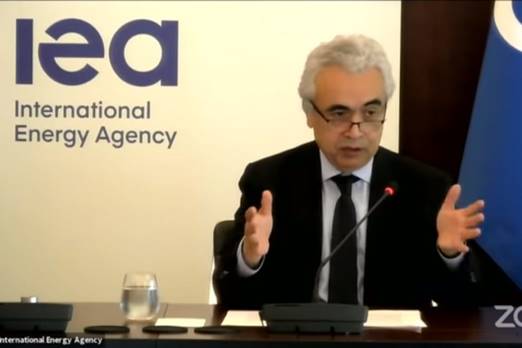
The International Energy Agency has unveiled a global
COVID-19 recovery plan for the global energy sector which outlines a three-year
series of actions designed to revitalize economies, boost employment and make
energy systems cleaner and more resilient.
At a live-streamed press briefing, IEA
executive director Dr Fatih Birol said: “Our numbers show that there has been a
huge impact across the energy sector, some parts more, some parts less, and a
big decline in carbon usage.
“We are putting on the table a road-map of how
to get out this crisis in better shape, [meaning] a much more modern, cleaner,
more resilient energy system, while energy policies give a boost to economic
growth, and help to create new jobs.”
The IEA’s Sustainable Recovery Plan offers an
energy sector pathway for governments to spur economic growth, create millions
of jobs and put global emissions into structural decline.
By integrating energy policies into government
responses to the economic shock caused by the COVID-19 crisis, the plan would
also accelerate the deployment of modern, reliable and clean energy
technologies and infrastructure.
In an analysis carried out in cooperation with
the International Monetary Fund, the report shows that the set of policy
actions and targeted investments over the 2021-2023 period that are outlined in
the Sustainable Recovery Plan can achieve a range of significant outcomes,
notably:
·
Boost global economic growth by an average of
1.1 percentage points a year;
·
Save or create roughly nine million jobs a
year;
·
Reduce annual global energy-related greenhouse
gas emissions by a total of 4.5 billion tons by the end of the plan.
In addition, the plan proposes other
improvements to human health and well-being, including driving a 5% reduction
in air pollution emissions, bringing access to clean-cooking solutions to
around 420 million people in low-income countries, and enabling nearly 270
million people to gain access to electricity.
The $3 trillion
dollar question
Achieving these results would require global
investment of about $1 trillion annually over the next three years. This sum
represents about 0.7% of today’s global GDP and includes both public spending
and private finance that would be mobilized by government policies.
“Governments have a once-in-a-lifetime
opportunity to reboot their economies and bring a wave of new employment
opportunities while accelerating the shift to a more resilient and cleaner
energy future,” said Dr Birol.
“Policymakers are having to make hugely
consequential decisions in a very short space of time as they draw up stimulus
packages. Our Sustainable Recovery Plan provides them with rigorous analysis
and clear advice on how to tackle today’s major economic, energy and climate
challenges at the same time. The plan is not intended to tell governments what
they must do. It seeks to show them what they can do.”
Based on detailed assessments of more than 30
specific energy policy measures, the Sustainable Recovery Plan considers
cost-effective approaches, the circumstances of individual countries, existing
pipelines of energy projects, and current market conditions. It spans six key
sectors – electricity, transport, industry, buildings, fuels and emerging
low-carbon technologies.
Employment is critical to the recovery
The IEA’s new energy employment database shows
that in 2019, the energy industry – including electricity, oil, gas, coal and
biofuels – directly employed around 40 million people globally. The special
report estimates that 3 million of those jobs have been lost or are at risk due
to the impacts
of the COVID-19 crisis, with another 3 million jobs lost or at risk in related
areas such as vehicles, buildings and industry.
The largest portion of the millions of new jobs
created through the Sustainable Recovery Plan would be in retrofitting
buildings to improve energy efficiency and in the electricity sector,
particularly in grids and renewables. The other areas that would see higher
employment include energy efficiency in industries such as manufacturing, food
and textiles; low-carbon transport infrastructure; and more efficient and new
energy vehicles.
Renewed
investment for ensured resilience
Recent IEA analysis has shown that global
energy investment is set for an unprecedented plunge of 20% in 2020, raising
serious concerns for energy security and clean energy transitions. According to
the IEA, as a result of the Sustainable Recovery Plan, the global energy sector
would become more resilient, making countries better prepared for future
crises.
Investment in enhancing electricity grids,
upgrading hydropower facilities, extending the lifetimes of nuclear power
plants, and increasing energy efficiency would improve electricity security by
lowering the risk of outages, boosting flexibility, reducing losses and helping
integrate larger shares of variable renewables such as wind and solar PV.
Electricity grids, the backbone of secure and reliable power systems, would see
a 40% increase in capital spending after years of declining investment. This
would put them on a stronger footing to withstand natural disasters, severe
weather and other potential threats.
The Sustainable Recovery Plan is designed to
avoid the kind of sharp rebound in carbon emissions that accompanied the economic
recovery from the 2008-2009 global financial crisis and instead put them into
structural decline. The IEA report highlights key aspects of today’s situation
that make it a unique opportunity for government action.
Compared with the 2008-2009 crisis, the costs
of leading clean energy technologies such as wind and solar PV are far lower,
and some emerging technologies like batteries and hydrogen are ready to scale
up. Global carbon emissions flat-lined in 2019 and are set for a record decline
this year. While this drop, which results from economic trauma, is nothing to
celebrate, it provides a base from which to put emissions into structural
decline.
“This report lays out the data and analysis
showing that a cleaner, fairer and more secure energy future is within our
reach. The Sustainable Recovery Plan would make 2019 the definitive peak in
global emissions, putting them on a path towards achieving long-term climate
goals,” Dr Birol said.
“The IEA is mobilizing its analytical resources
and global convening power to bring together a grand coalition that encompasses
government ministers, top energy industry CEOs, major investors and other key
players who are ready to pursue a sustainable recovery that will help steer the
world onto a more resilient trajectory. This is why the Sustainable Recovery
Plan will be a key element informing discussions at the IEA Clean Energy
Transitions Summit on 9 July.”
The IEA Clean Energy Transitions Summit on 9
July will gather ministers from countries representing 80% of global energy
use, as well as industry CEOs, big investors and other key leaders from the
public and private sectors around the world.
The high-level virtual dialogue will review
both near-term actions for sustainable recovery and measures to accelerate
clean energy technology innovation for reaching long-term decarbonization
plans.







